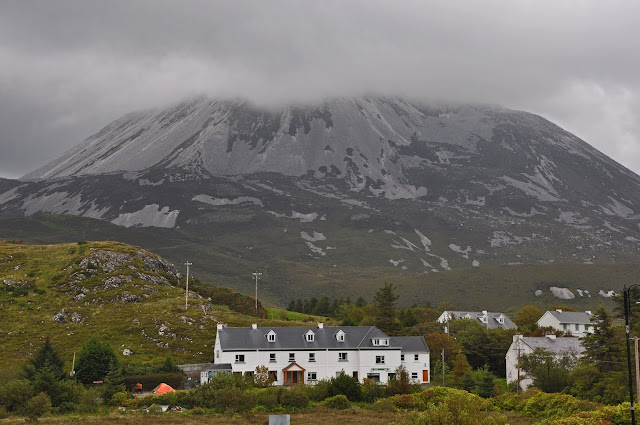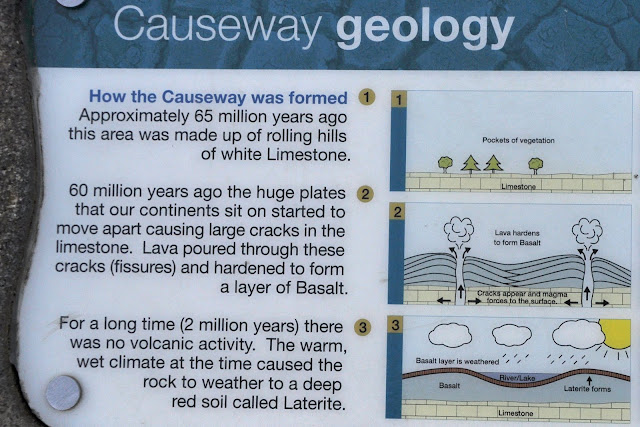 |
| Achill Island, near Dooagh |
 |
| Trawmore strand, near Keel |
 |
| Kildavnet Tower, Achill |
 |
 |
| Leenane, across Killary Fijord |
 |
| Horseback riding on beach, near Westport |
 |
| Kildownet (Kildavnet) Church ruins, Achill Island |
 |
| Kildavnet Tower House "Grace O'Malley's Castle" |
 |
| Rockfleet Tower, under repair |
"... Here amid the gloom and the dark wind, rises a land populous in parts with cottages as a city with human beings. It is a place of tiny dwellings and tiny farms. Out in the fields you see the women labouring and bringing wonder into the rocky darkness of the island with their heavy petticoats of red and blue that you will not surpass for color in a Titian. The men dig the earth into strange shapes - furrows and ridges that you would conceive might be dug blindly by night. The social spirit is here, however, making continual war on the hungry bareness of things. The people delight in dancing and song and old men scrape a living from twittering fiddles on the earthen cottage floors in the evenings."
(from 'Home Life in Ireland', quoted in Mary Cosgove, 'Paul Henry and Achill Island', in Ullrich Kockel (Ed), 'Landscape, Heritage and Identity', pub. Liverpool University Press, 1995)
The weather is inevitable the ice breaker when you talk to someone here. Especially (as the Irish say) the last month was the worst May they could remember being quite windy and rainy. Today I was discussing the weather with a patient who said ''You have to dance with the tune that's played for you.''
I went for a day drive to Achill Island, in county Mayo, after bidding farewell to my family earlier in the day, at the bus stop. This was a scenic drive. I went north from Carna, via Leenane, around the Killary fjord, up the Doolough Valley route via Louisberg, around Crough Patrick, thru Westport, then along the ''Alantic Drive'' coastal route, west to Achill Island, via a bridge.
I am quite impressed with county Mayo, it is different then my county Galway, less rocky. Mostly rural, with sweeping landscapes. Ireland impresses me that for its' size, there is so much interesting geography, then you throw in the ruins and the interesting culture...
I did not arrive to Achill until mid-afternoon, due to a late start, and multiple photo op stops on the way. Highlites included the Doolough Valley drive from Leenane to Louisberg, the beach before Westport with horseback riders, vistas of Crough Patrick and the Atlantic Drive.
Crough Patrick is nicknamed the Reek, a 764 meters (2,507 ft) tall mountain by Irish standards, and an important site of pilgrimage. On "Reek Sunday", the last Sunday in July every year, over 15,000 pilgrims climb it, many barefoot! Saint Patrick reputedly fasted on the summit of Croagh Patrick for forty days in the fifth century and built a church there. Popular legend says that at the end of Patrick's fast, he threw a silver bell down the side of the mountain, knocking the she-demon Corra from the sky and banishing all the snakes from Ireland.
I continues NW, stopping at a nice beach on Clew Bay, watching some horseback riders. Then, I drove via Westport north, and then west, on the Atlantic Drive, which is a coastal route to Achill Island. Good vistas of the coast and Crough Patrick. I covered the Corraun Peninsula, finally crossing a bridge to Achill Island.
Achill is the largest Irish island, with multiple blue flag beaches, and some interesting ancient sites. It is a destination for Irish campers. In the past, fishing was a significant activity but this aspect of the economy is small now. At one stage, the island was known for its shark fishing, basking shark in particular was fished for its valuable liver oil.
Granuaile, the Pirate Queen, maintained a castle at Kildownet in the 16th century. It is currently undegoing repairs. She is buried under a similar tower of hers, on Clare island. James Joyce used the legend of Gráinne Ní Mháille ("her grace o'malice") in chapter 1 of Finnegans Wake. I also saw an ancient church and cemetery at Kildavnet. There is a monument there to the Clew Bay drowning of 1894, discussed below.
In 1894, the Westport railway line was extended to Achill Sound. The train station is now a hostel. The train provided a great service to Achill, but it also fulfilled an ancient prophecy. Brian Rua O' Cearbhain had prophesied that 'carts on iron wheels' would carry bodies into Achill on their first and last journey. In 1894, the first train on the Achill railway carried the bodies of victims of the Clew Bay Drowning. This tragedy occurred when a boat overturned in Clew Bay, drowning thirty two young people. They had been going to meet the steamer which would take them to Scotland for potato picking.
The Kirkintilloch Burning Disaster in 1937 fulfilled the second part of the prophecy, when the bodies of ten victims were carried by rail to Achill. These people had died in a fire in a 'bothy'. This term referred to the temporary accommodation provided for those who went to Scotland to pick potatoes.Next was Keel, a picturesque coastal setting, with Trawmore strand, the best known beach on Achill, almost 2 miles long. There were mild waves, good for young surfers. People camped behind the dunes, an ideal setting. Then, I continued along the coast on a cliff top road, to Keem Bay, at the western tip of Achill. Reportedly, there is amethyseth in the cliffs around this area.
There is a famous painting by the artist Paul Henry 'Launching the Currach' set here. For Paul Henry Achill Island was love at first sight and he instantly decided to remain on the island, tearing up his return rail ticket and scattering the fragments into the sea. Henry castigated the young girls on Achill for turning up to model wearing modern silk stockings and high heeled shoes, rather than barefoot and in the everyday clothes handed down to them by their grandmothers. Paul Henry often had to sketch surreptitiously in the villages on Achill, hiding his sketchpad inside a book. There is scant reference in any of Paul Henry's works to the civil upheavals that transformed Ireland during his lifetime, nor any attempt to engage with the underlying political reasons for the harshness of life for the people of Achill Island. He chose instead to focus on a timeless struggle between man and nature - sometimes harmonious, as in the landscapes with cottages, and sometimes tragic, as in the Synge-inspired 'Waiting for the Boats'. He explained this painting: "... One morning the long Atlantic rollers were thundering on the cliffs as I came round a corner and saw a group of men and women huddled together on a promontory - they had been there all night their eyes searching the troubled waters for a sight of the fishing boats which were never to come home'. Paul Henry painted the spiritual heart of Ireland "... There are not a few artists who would despair of redeeming from sordidness a string of unkempt cabins, with turfstacks heaped against the white-washed gables, and rain-water standing in pools on the broken roadway. But in Mr Henry's hands this becomes not merely dignified but epochal, a symbol of the spirit of the West'.
After Keem, I went to the northern coast of Achill, where I walked up the slope of Slievemore to a megalithic tomb, situated with great vistas of Achill Island. There is a lot more to see on this beautiful island, but I had to leave, as it was getting dark.
There is a famous painting by the artist Paul Henry 'Launching the Currach' set here. For Paul Henry Achill Island was love at first sight and he instantly decided to remain on the island, tearing up his return rail ticket and scattering the fragments into the sea. Henry castigated the young girls on Achill for turning up to model wearing modern silk stockings and high heeled shoes, rather than barefoot and in the everyday clothes handed down to them by their grandmothers. Paul Henry often had to sketch surreptitiously in the villages on Achill, hiding his sketchpad inside a book. There is scant reference in any of Paul Henry's works to the civil upheavals that transformed Ireland during his lifetime, nor any attempt to engage with the underlying political reasons for the harshness of life for the people of Achill Island. He chose instead to focus on a timeless struggle between man and nature - sometimes harmonious, as in the landscapes with cottages, and sometimes tragic, as in the Synge-inspired 'Waiting for the Boats'. He explained this painting: "... One morning the long Atlantic rollers were thundering on the cliffs as I came round a corner and saw a group of men and women huddled together on a promontory - they had been there all night their eyes searching the troubled waters for a sight of the fishing boats which were never to come home'. Paul Henry painted the spiritual heart of Ireland "... There are not a few artists who would despair of redeeming from sordidness a string of unkempt cabins, with turfstacks heaped against the white-washed gables, and rain-water standing in pools on the broken roadway. But in Mr Henry's hands this becomes not merely dignified but epochal, a symbol of the spirit of the West'.
After Keem, I went to the northern coast of Achill, where I walked up the slope of Slievemore to a megalithic tomb, situated with great vistas of Achill Island. There is a lot more to see on this beautiful island, but I had to leave, as it was getting dark.
Will you meet me on Clare Island
Summer stars are in the sky
We’ll get the ferry out from RoonaghAnd wave all our cares goodbye
And we’ll go dancing at the ceili
We’ll go kissing on the strand
Take our clothes off in the moonlight
Skinny-dipping hand in hand
And we’ll start drinking in the twilight
Keep it up until the dawnIn both the bars
Because there’s no guards
To take our names and send us home.
First verse, Clare Island, the Saw Doctors



























































































































































































































